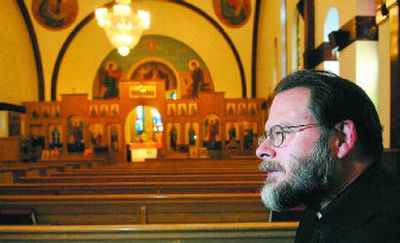Growing faith

For decades, only Greek was sung and spoken during services at Holy Trinity Greek Orthodox Church.
The congregation, after all, was founded by families from Greece who had made Spokane their new home.
These days, Greek is just one of more than a dozen languages spoken by this diverse community of believers. While the Lord’s Prayer and the Nicene Creed – the Orthodox Church’s basic statement of faith – are still prayed out loud in Greek, English has become the church vernacular.
In fact, the Rev. Stephen Supica not only sings the hymns in English and Greek, he also repeats the words in Old Church Slavonic, a Slavic language sometimes used in liturgy.
“It’s as much comfort food as comprehensibility,” said Supica, the church’s pastor since 1988. “It allows everyone to feel at home.”
Holy Trinity, a church that was established by Greek immigrants in the 1930s, has now become a melting pot of cultures. While about 30 percent of its members are of Greek descent, many others are from Armenia, Bulgaria, Lebanon, Serbia, Russia, Eritrea and other parts of the world. A growing number are also converts to the faith.
As Holy Trinity celebrates the 60th anniversary of its church building this weekend, many are paying tribute to the parish’s Greek heritage while continuing to embrace the congregation’s growing diversity.
“When orthodoxy first came to the mainland United States, the church provided a community for immigrants,” said Holy Trinity parishioner Nick Damascus, describing the transformation experienced by many Orthodox churches in America. “Now that they’re part of the fabric of this country, they’re beginning to reach out and spread their faith.”Orthodoxy — a faith tradition that claims to be the original Christian church founded by Jesus and the apostles — continues to draw a growing number of believers, said Damascus, who was baptized at Holy Trinity as an infant in 1946.
According to estimates by Orthodox researchers, Orthodox Christians number about 1.2 million in the United States.
Locally, the number of Orthodox churches has also grown. Holy Trinity was the only Orthodox church between Seattle and Butte, Mont., for decades, according to Supica. Now, the Spokane-Coeur d’Alene area has become home to a half-dozen Orthodox churches, including St. John the Baptist in Post Falls and Christ the Savior in Spokane Valley.
Holy Trinity, a parish of about 150 families, is still the best known in the region – not just for its annual Greek Dinner Festival, a culinary tradition for more than 70 years, but also for the church’s distinctive Byzantine architectural style and its sanctuary full of icons, stained-glass windows and gold.
Although the domed church on North Washington Street wasn’t built until 1948, Holy Trinity parish has actually been in existence since 1932. After worshipping in a nearby chapel, members raised the money to build an actual house of worship. Late last year, the church received its most recent makeover: a roof and dome covered in solid copper.
“…With faith in God and love of Orthodoxy, a small, yet vibrant community of Greek Orthodox Christians gathered together and pooled their efforts and resources to build a beautiful Byzantine-style church,” wrote Eleni Schumacher, the parish council president. “With gratitude for their foresight and respect for their determination, we thank them now 60 years later.”
While Greek is no longer as widely spoken as it used to be, all the parishioners – from the older generation whose parents and grandparents helped establish the church all the way to the newest converts – remain devoted to Orthodoxy’s ancient traditions, including a liturgy that hasn’t changed for more than 1,000 years.
“The aim and purpose of our parish is to keep, practice and proclaim the Orthodox Christian Faith pure and undefiled,” according to Holy Trinity’s website.
Orthodoxy is a branch of Christianity that closely preserves the rituals of the early church. For the first thousand years of Christianity, the churches operated under regional affiliates. That ended with Great Schism of 1054, resulting in two Christian churches: Roman Catholic and Eastern Orthodox.
Orthodox churches say they have continued the traditions of the original Christian faith, dating back to the days of the apostles.
Steeped in liturgy, ritual and tradition, orthodoxy appeals to a wide variety of believers.
George Alex, whose family joined the church in 1937 when he was only four years old, remains grateful to the founders of Holy Trinity. Now in his 70s and still fluent in Greek, Alex said those early leaders had the dedication and foresight to build a church and community that continues to thrive today.
Michelle Zeran, 36, became a member about three years ago after spending most of her life not believing in God. “I felt like I came home,” she said, describing the experience of liturgy and learning more about Orthodoxy. “If you look at the history of the Orthodox Church, the church has always taught the same thing. It’s the same faith that has existed since 33 A.D. Since Pentecost all the way through today, the exact same faith has been proclaimed.”
As they continue to learn more about their faith through worship and community, some of the recent converts have also started learning Greek by taking weekly language classes at the church.
“For the people who grew up hearing Greek in church, (praying and singing hymns in Greek) gives them a sense of connectedness to the past,” Supica said. “For others, the language helps connect them to something that goes back a long way, back to the very beginning.”